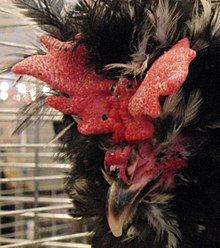 A black mottled hen A black mottled hen | |
| Other names | French: Poule de Houdan |
|---|---|
| Country of origin | France |
| Standard | Standard-sized (in French) Bantam (in French) |
| Use | meat, eggs, fancy |
| Traits | |
| Weight |
|
| Egg colour | white |
| Comb type |
|
| Classification | |
| APA | continental |
| ABA | all other comb clean legged |
| EE | yes |
| PCGB | rare soft feather: heavy |
| Notes | |
| five-toed | |
| |


The Houdan (French pronunciation: [udɑ̃] ) or Poule de Houdan ([pul də udɑ̃]) is an old French breed of domestic chicken. It is named for its area of origin, the commune of Houdan, in the département of Yvelines to the west of Paris. It belongs to the crested chicken group, is muffed and bearded, has an unusual leaf-shaped comb, and has five toes on each foot rather than the usual four.
History
The Houdan is a traditional French breed; its origins are unknown. It was described in detail by Charles Jacque in 1856 and 1858. The Houdan combines a number of distinctive features, which in the nineteenth century gave rise to speculation about the breeds that might have contributed to its development; the Crèvecœur, Dorking and Polish have been mentioned as possible "ancestors".
It was first imported into England in 1850, and to North America in 1865, where it appeared in the first edition of the American Standard of Perfection in 1874.
Characteristics
The Houdan is crested, muffed and bearded, has an unusual leaf-shaped comb, and has five toes on each foot rather than the usual four. The earlobes and wattles are small, and may be mostly or completely hidden by the feathering. The comb is leaf- or butterfly-shaped in European and Australian standards; in the United States it is v-shaped.
The most common colour variety, and the only one recognised in the United Kingdom, is mottled (or caillouté, "pebbled" in France), a pattern of black with white spotting. In the past there was a lighter variation of the mottled pattern; in the 1800s, it may have been more similar to the splashy mixture of white and black which today is called exchequer. Three other colour varieties are recognised in France: black, pearl-grey, and white. In the Poultry Standard for Europe of the Entente Européenne d'Aviculture et de Cuniculture the black mottled, cuckoo, pearl-grey and white are recognised; a black variety is listed but unrecognised. The white variety was developed in the United States. Other colours were known in the past, including blue mottled and red.
Although it is classified by the Poultry Club of Great Britain as heavy, the Houdan is a light breed: cocks weigh 2.5–3 kg and hens 2–2.5 kg. A bantam Houdan was created in Britain shortly after the end of the Second World War, and developed further in Germany and in France.
Use
The Houdan was formerly a dual-purpose fowl, kept for both eggs and meat: for part of the nineteenth century it was one of the principal meat breeds of France. In the twenty-first century it is an endangered breed, and is reared primarily for showing.
Hens may give some 140–160 eggs per year; they are white, and not large.
References
- ^ APA Recognized Breeds and Varieties: As of January 1, 2012. American Poultry Association. Archived 4 November 2017.
- ^ Liste des races et variétés homologuée dans les pays EE (28.04.2013). Entente Européenne d’Aviculture et de Cuniculture. Archived 16 June 2013.
- Breed Classification. Poultry Club of Great Britain. Archived 12 June 2018.
- ^ Jean-Claude Periquet (2015). Races de poules et de coqs de France (in French). Paris: France agricole. ISBN 9782855573861.
- Charles Emile Jacque (1858). Le poulailler: monographie des poules indigènes et exotiques, aménagements, croisements élève, hygiène, maladies, etc. (in French). Paris: Librairie agricole de la maison rustique.
- ^ Charles Lee (1874). A Practical Guide to the Breeding, Feeding, Rearing and General Management of the Houdan Fowl. London: W. Hawkins.
- Victoria Roberts (2008). British poultry standards: complete specifications and judging points of all standardized breeds and varieties of poultry as compiled by the specialist breed clubs and recognised by the Poultry Club of Great Britain. Oxford: Blackwell. ISBN 9781405156424.
- ^ Carol Ekarius (2007). Storey's Illustrated Guide to Poultry Breeds. North Adams, Massachusetts: Storey Publishing. ISBN 9781580176675.
- ^ J. Ian H. Allonby, Philippe B. Wilson (editors) (2018). British Poultry Standards: complete specifications and judging points of all standardized breeds and varieties of poultry as compiled by the specialist breed clubs and recognised by the Poultry Club of Great Britain, seventh edition. Chichester; Hoboken, New Jersey: Wiley Blackwell. ISBN 9781119509141.
- ^ Luuk Hans (February 2009). Vive La France. Aviculture Europe. 5 (1), article 9. Archived 31 May 2011.
- Craig Russell (2000). Old French Breeds: Houdans and Crevecoeurs. SPPA Bulletin. 5 (2):3–4. Society for Preservation of Poultry Antiquities.
- Jeremy Hobson, Celia Lewis (2007). Keeping Chickens. Newton Abbot, Devon; Cincinnati, Ohio: David and Charles. ISBN 9780715325674.
- Standard de la Houdan (in French). Houdan–Faverolles Club de France. Accessed August 2014.
- Chris Graham (2006). Choosing and Keeping Chickens. London: Octopus Publishing. ISBN 9780793806010.